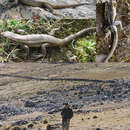Liolaemus pachacutec: Brief Summary
provided by wikipedia EN
Liolaemus pachacutec is a species of lizard in the family Iguanidae. It is endemic to Peru.
- license
- cc-by-sa-3.0
- copyright
- Wikipedia authors and editors
Description
provided by Zookeys
Adult male; SVL 44.8 mm; head length 11.0 mm; head width 8.2 mm; head height 6.2 mm; axilla-groin distance 18.4 mm (41.1% of SVL); foot length 13.6 mm (30.4% of SVL); tail length 74.9 mm. (1.7 times SVL).
Dorsal head scales 16, dorsal head scales smooth, scale organs more abundant in loreal and supralabial regions. Two scale organs on postrostral. Nasal scale in contact with rostral, separated from first supralabial by one scale, nasal bordered by six scales; canthus separated from nasal by one scale. Four supralabials. Four lorilabials scales and one in contact with the subocular. Five infralabials. Auditory meatus oval (height 2.0 mm, width 1.0 mm), with two small, projecting scales on anterior margin. Six convex, smooth temporals (counting vertically from buccal commissure to posterior corner of orbit). Orbit–auditory meatus distance 3.9 mm. Orbit–anterior margin of rostral distance 4.3 mm. Rostral about two times wider than high (width 2.3 mm; height 1.0 mm). Mental subpentagonal, about two times as wide as high (width 2.5 mm; height 1.0 mm). Interparietal pentagonal with an elongated posterior apex, bordered by five scales, the parietal of similar size. Frontal trapezoidal.
Supraorbital semicircles complete on both sides. Semicircles formed by six scales. Five enlarged supraoculars. Six distinctly imbricate superciliaries on both sides. Eleven upper and lower ciliaries. Subocular elongate, 2.8 mm, longer than eye diameter (2.1 mm; measured between anterior and posterior commissure of ciliaries), separated from supralabials by a single, but interrupted row of lorilabials. Fourth supralabial elongate, 2.0 mm. Four lorilabials with single row of scale organs. Fourth lorilabial contacting subocular. Preocular small, separated from lorilabial row by one scale. Postocular as large as preocular. Mental in contact with four scales: first infralabials (on each side) and two enlarged chin shields. Chin shields forming a longitudinal row of four enlarged scales separated one from the other by six smaller scales. Scales of throat round, flat, and imbricate. Twenty-two gulars between auditory meatus. Longitudinal neck fold without keeled scales and smaller in size than dorsal scales. Antehumeral pocket and antehumeral neck fold well developed. Thirty-six scales between auditory meatus and shoulder (counting along postauricular and longitudinal neck fold), twenty-six scales between auditory meatus and antehumeral neck fold. Gular folds absent.
Dorsal scales rhomboidal, keeled, and imbricate. Forty-two dorsal scales between occiput and level of groin. Forty-five scales around midbody. Nineteen rows of keeled scales on dorsum at midtrunk. Scales becoming smooth along flank and toward belly. Ventral scales slightly wider than dorsals. Seventy-seven ventral scales between mental and precloacal pores. Five precloacal pores. Supracarpals laminar, round, and smooth. Subdigital lamellae of fingers with three keels, in number I: 8; II: 12; III: 16; IV: 18; V: 12 (right fingers). Claws moderately long. Supradigital lamellae convex, smooth, and imbricate. Infracarpals and infratarsals keeled, distinctly imbricate. Supratarsals smooth. Subdigital lamellae of toes I: 10; II: 14; III: 18; IV: 22; V: 15 (right toes).
- license
- cc-by-3.0
- copyright
- César Aguilar, Perry L. Wood Jr, Juan C. Cusi, Alfredo Guzmán, Frank Huari, Mikael Lundberg, Emma Mortensen, César Ramírez, Daniel Robles, Juana Suárez, Andres Ticona, Víctor J. Vargas, Pablo J. Venegas, Jack W. Sites Jr
- bibliographic citation
- Aguilar C, Wood Jr P, Cusi J, Guzmán A, Huari F, Lundberg M, Mortensen E, Ramírez C, Robles D, Suárez J, Ticona A, Vargas V, Venegas P, Sites Jr J (2013) Integrative taxonomy and preliminary assessment of species limits in the Liolaemus walkeri complex (Squamata, Liolaemidae) with descriptions of three new species from Peru ZooKeys 364: 47–91
- author
- César Aguilar
- author
- Perry L. Wood Jr
- author
- Juan C. Cusi
- author
- Alfredo Guzmán
- author
- Frank Huari
- author
- Mikael Lundberg
- author
- Emma Mortensen
- author
- César Ramírez
- author
- Daniel Robles
- author
- Juana Suárez
- author
- Andres Ticona
- author
- Víctor J. Vargas
- author
- Pablo J. Venegas
- author
- Jack W. Sites Jr
Distribution
provided by Zookeys
Liolaemus pachacutec sp. n. is known from four localities in the central Andes, at elevations of 4023–4972 m in the departments of Cusco and Apurímac in southeastern Peru (Fig. 11). The species was found under rocks in grassland habitats (Fig. 9). It was found in sympatry at similar elevations with Liolaemus ortizi Laurent, 1982 and Tachymenis peruviana Wiegmann, 1835. This species is probably viviparous; two females showed one or two uterine chambers per side, with an embryo and abundant yolk in each chamber, but without a visible shell.
- license
- cc-by-3.0
- copyright
- César Aguilar, Perry L. Wood Jr, Juan C. Cusi, Alfredo Guzmán, Frank Huari, Mikael Lundberg, Emma Mortensen, César Ramírez, Daniel Robles, Juana Suárez, Andres Ticona, Víctor J. Vargas, Pablo J. Venegas, Jack W. Sites Jr
- bibliographic citation
- Aguilar C, Wood Jr P, Cusi J, Guzmán A, Huari F, Lundberg M, Mortensen E, Ramírez C, Robles D, Suárez J, Ticona A, Vargas V, Venegas P, Sites Jr J (2013) Integrative taxonomy and preliminary assessment of species limits in the Liolaemus walkeri complex (Squamata, Liolaemidae) with descriptions of three new species from Peru ZooKeys 364: 47–91
- author
- César Aguilar
- author
- Perry L. Wood Jr
- author
- Juan C. Cusi
- author
- Alfredo Guzmán
- author
- Frank Huari
- author
- Mikael Lundberg
- author
- Emma Mortensen
- author
- César Ramírez
- author
- Daniel Robles
- author
- Juana Suárez
- author
- Andres Ticona
- author
- Víctor J. Vargas
- author
- Pablo J. Venegas
- author
- Jack W. Sites Jr

